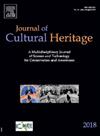Active thermography for the analysis and conservation of Roman lead pipes at the Baia archaeological park
IF 3.3
2区 综合性期刊
0 ARCHAEOLOGY
引用次数: 0
Abstract
The conservation and study of ancient cultural heritage artifacts, particularly those that have been buried or weathered over time, present considerable challenges. Among these artifacts, Roman lead pipes (fistulae plumbeae) require non-destructive methods to assess their condition and reveal hidden details. This study explores the application of active thermography (AT) as a non-destructive method for analyzing these artifacts, focusing on three distinct thermal stimulation techniques: hot air, long light pulse, and short light pulse. The analysis was conducted on three fistulae plumbeae from the Baia Archaeological Park, including a detailed case study on the Pisones fistula. Advanced thermal data processing techniques, such as Maximum Thermal Gradient, Thermal Recovery, and Principal Component Thermography, were employed to assess the conservation state of these pipes. The findings demonstrate that AT effectively identifies areas of deterioration, encrustations, and impurity accumulation, while also providing insights into the impact of restoration interventions. This pioneering research highlights the potential of infrared thermography for the non-destructive analysis of Roman lead pipes and underscores the broader applicability of thermal imaging technologies in cultural heritage conservation.
巴亚考古公园罗马铅管的主动热成像分析和保护
保护和研究古代文化遗产,特别是那些被掩埋或风化的文物,面临着相当大的挑战。在这些文物中,罗马铅管(瘘管)需要非破坏性的方法来评估它们的状况并揭示隐藏的细节。本研究探讨了主动热成像(AT)作为一种非破坏性方法来分析这些伪影的应用,重点研究了三种不同的热刺激技术:热空气、长光脉冲和短光脉冲。对巴亚考古公园的3个管状瘘管进行了分析,包括对Pisones瘘管的详细案例研究。采用先进的热数据处理技术,如最大热梯度、热恢复和主成分热成像,来评估这些管道的保存状态。研究结果表明,AT有效地识别了退化、结壳和杂质积累的区域,同时也为修复干预的影响提供了见解。这项开创性的研究突出了红外热成像技术在古罗马铅管无损分析方面的潜力,并强调了热成像技术在文化遗产保护方面的广泛适用性。
本文章由计算机程序翻译,如有差异,请以英文原文为准。
求助全文
约1分钟内获得全文
求助全文
来源期刊

Journal of Cultural Heritage
综合性期刊-材料科学:综合
CiteScore
6.80
自引率
9.70%
发文量
166
审稿时长
52 days
期刊介绍:
The Journal of Cultural Heritage publishes original papers which comprise previously unpublished data and present innovative methods concerning all aspects of science and technology of cultural heritage as well as interpretation and theoretical issues related to preservation.
 求助内容:
求助内容: 应助结果提醒方式:
应助结果提醒方式:


